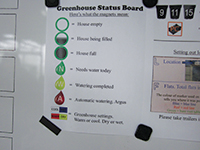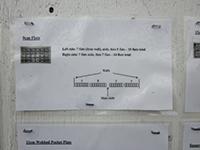
Once the Lean measures have been completed, it’s time to ensure the momentum is maintained.

|
|
| Establish a status board for all employees to review.
|
Welcome back! In this month’s article we will bring the Valleybrook Lean project to completion.
The project team has made their way through the Define, Measure, Analyze and Improve phases of the DMAIC cycle and now just need to finish the Control phase to make sure it doesn’t slip.
Control is a unique stage of any process improvement project. It’s not so much an activity but rather a validation of the work completed. It also means ensuring that it will be sustained. Too many times changes are made and we rely on a memo, sign, policy, procedure or meetings to inform others of the new way of doing something. This usually is not sustainable and the process just slips back to the old way of doing business.
SIGNIFICANT IMPROVEMENTS TO BASELINE MEASUREMENTS
One of the best controls takes us all the way back to the start of the project when we measured our baseline. We knew the team was laying down an average of 64.4 flats per hour per team. The improvements increased that rate this year to 71.6 flats per hour and as high as 90 flats per hour.
Peter Drucker once stated, “what gets measured gets done.” We take this literally and measures should be posted in the work area so the team can see how they are performing.
“WHAT GETS REWARDED, GET’S REPEATED”
This action is validated by John E. Jones, who added to Druckers statement by saying: “what gets measured gets done, what gets measured and fed back gets done well, what gets rewarded gets repeated.”
Other improvement controls that are effective are the fundamental changes to the process. Instead of measuring for rows in the greenhouses, perm-anent lines on the floor takes the guessing out of the process. These are called Poka Yokes or mistake-proofing devices.
There are two types – prevention and detection.
- Prevention devices don’t allow us to make a mistake. These are things like your car door not locking while the keys are in the ignition or electrical plugs only going into the receptacle one way.
- Detection devices only warn us we are going to make a mistake… but we can still make that mistake. For example, a red traffic light tells us we shouldn’t go through the intersection but we can still drive through it. The lines on the ground in the greenhouse would be considered a detection Poka Yoke, as they show us how it should be done, but they do not prevent a mistake from happening.

|
|
| Attention to detail is important.
|
CREATING PROCEDURES FOR “STANDARD WORK”
Another fundamental change was only having one driver take the trailers to the greenhouse and dropping the trailer. This is known as standard work. Standard work is not about making robots of the staff. It’s finding the best way to do something, validating it by measuring it, and then using the new process. It can be posted in the area with simple steps on how to complete a task or where to put something away. Standard work can also be communicated by visual management. This can be by colour coding, putting signs in an area or marking lines on the ground.
The changes in Valleybrook have proven positive for both the staff (easier and more diverse work) and the organization (cost efficiency).
Now that this project is complete, what do we do?
Lean is a continual process of quality improvement and it is often referred to as a journey, not a destination. Valleybrook has created what we refer to as capacity, people who have completed an improvement cycle. They have infrastructure; the tools and materials to physically complete change. They also have leadership commitment, which is crucial.
When an organization gets to this point, all they have to worry about is too much pull from staff wanting to make changes in their area, which is not a bad thing. But as an organization, you have to control spread. If change takes off too quickly you run the risk of processes being changed without following the rigour of the DMAIC cycle, too slow a pace of growth will cause the program to die. The proper pace is important, as well as communication and celebrating successes.
VALLEYBROOK EMBRACING A SOLID LEAN PROGRAM
I want to thank Paula and Greg Baxter from Valleybrook for their great vision and diligence in creating a solid Lean program. All the right pieces of the puzzle are in place for Valleybrook’s quality improvement journey to be long and fruitful.
This project was made possible through the Food Innovation Centre of BC (www.foodinnovationcentre.ca ) with funding through the federal-provincial-territorial Growing Forward program.
Next month’s article will focus on 5S… and how it can get you big gains.
| LTS AN AWARD-WINNING COMPANY
Dale Schattenkirk, president/CEO of LTS Consulting, has over 12 years of experience in consulting, training, development and implementation of Lean Six Sigma methodology. He is an expert in transformational change and works with all levels of the organization from frontline staff to CEOs to teach them how to apply Lean Six Sigma in their settings and what it takes to be a leader in a Lean Six Sigma organization. Schattenkirk is a certified Lean Six Sigma Black Belt, an ISO Auditor and a Certified Human Resources Professional (CHRP). |
Print this page